The flat-top tower crane is characterized by its quick, easy assembly. The compact head is mounted by an auto crane in a single lift. All drive pedestals and rails are designed to last. All drives are easy and safe to reach for maintenance work straight from the compact head.
The newly designed comfort cab is attached and removed by means of quick-release fastenings and is identical for all small and medium-sized cranes. This cuts crane fleet costs.

Flat top tower crane advantages
The most important advantage is related to the useful life of the crane. It is a well-known fact that alternating stresses cause bigger fatigue in structures than unidirectional forces.
Flat top cranes, due to the design, have practically no alternative stresses in the jib or counter-jib structure. Regardless of where the trolley and load are situated, the upper part of the jib is always working in tension and the lower part of the jib is always working in compression.
In the same way, the lattice tubes and welds on the jib are always working in tension or compression only.
This means that there is no fatigue in the structure because the efforts are transmitted always in the same way. There are no alternative efforts.

Tower Crane
In the pendant lines tower cranes, the jib is transmitting the forces through the structure to the pendant line and then to the head, but the structure of the jib is not as strong of the one in the flat-top cranes.
So the jib of the crane is moving continuously up and down, transmitting the movements of the load to the pendant line, creating great fatigue in the structure due to the efforts are transmitted not always in the same way.
Construction crane
The most typical is very clear: if there is a project in which there will be several cranes working at the same time, and some of them are going to work over between them, working with flat top cranes could give the project manager some definitive advantages by reducing the height between the cranes.
There is no need to add extra height just to get over the pendant lines of the neighboring crane, which means not only extra mast sections but sometimes even wall-ties if the additional height exceeds the free-standing height of the crane. Law requires a minimum height between the highest part of one crane and the lowest part of the other crane (where cranes are going to overlap).
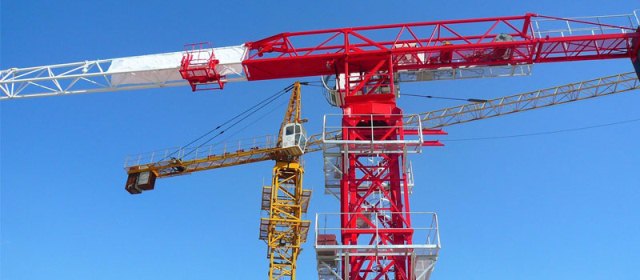
Flat top crane
Flat top cranes allow getting maximum hook height, with minimum overall height. The last result is that the final cost of the crane is smaller by reducing mast sections and time to erect them.
Flat top tower cranes mean fewer complications and more safety for the erector.
When sire conditions and access are bad, the jib can be erected in several jib sections one after the other, direct from the truck instead of being placed on the ground, preassembled and then lifted and placed in one piece, which makes the erection fast, simple and economic.
With pendant lines, at least the part, up to the pendant line is connected, must be assembled in one part and then the rest of jib could be done by piece.
Flat top tower cranes, a smaller mobile crane is required due to the lower weight of the single jib sections, as opposed to a complete jib. Furthermore, the erection of the jib sections is very simple, because the upper part of the union between two jib sections is normally pinned together without even needing a hammer. The lower rails automatically locate together just by lowering the jib section and final fixing of the side rails is by one simple longitudinal bolt on each side of the jib.
Also during the erection work of the jib the erectors are always in a safe position because they never have to leave the jib structure to erect tie ropes as on conventional pendant lines cranes.
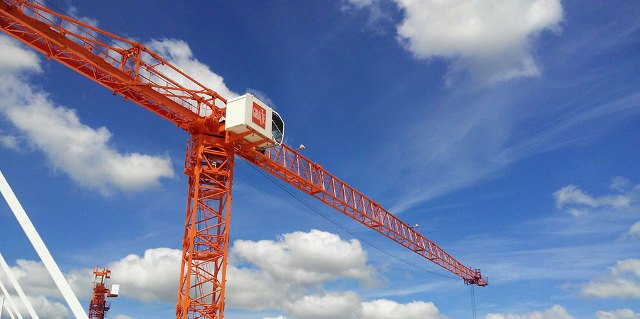
Tower crane maintenance
The design of the Flat top tower cranes allows reducing time and therefore costs in the maintenance works done by the technical people.
The slewing motor (s), the hoisting motor (depends on the model) and the electrical cabinets are installed in the slewing part of the crane.
All the most important parts to do the minimum maintenance are installed much close to others, so erectors don´t need to move from one side to the other of the crane.
Tower crane specifications
The Flat tower crane is designed according to their production line and trying to reduce storage costs in the final customers and in the rental fleets.
Because of this, all the cranes in every series have the same structural parts and components.
So having different cranes from the same series (and from other series), the number of parts needed to have in their yard is reduced up to a minimum. The interchangeability between cranes from the same family is total.
Also, having the most important components in the slewing part assemble together, the possibility of having a loss during the storage time is reducing a lot.
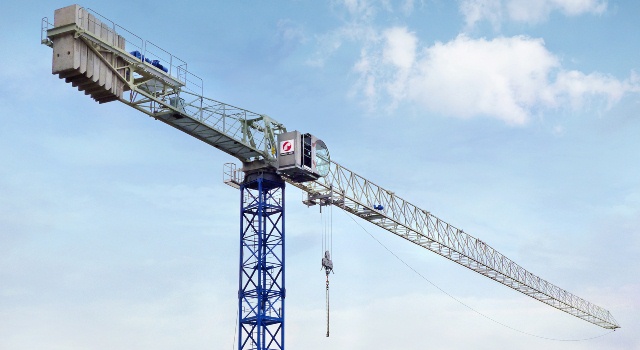
Tower crane design
Flat top tower cranes are designed to save money, not only during the erection works but during transportation.
The structure of the crane is ready to be combined between them in a truck and in containers to adjust up to the maximum space and the final load and save money by using fewer trucks and containers than the competitors.
One important feature of the Flat top tower cranes is that the mast sections are designed by panels.
Each mast section comprises 4 identical panels. All are joined together by double shear bolts.
This prevents the joints from coming loose and flaring, as they may in single shear systems, and also aligns stresses with the joints to the uprights.
The main stress (compression) is transmitted by contact between uprights, with the joint (bolts & lugs) working only under traction.
These panels sections are designed as a modular system so that different sections can be combined for better height performance.
The manufacturing systems used assured full interchangeability of components in sections, so that any panel can be replaced by another of the same type, and guarantees the structural function for stress transmission as per the design.
This is guaranteed via:
- The precision in length of the main uprights, achieved by machining them.
- The precision with which joints between section and diagonals are carried out, with multiple drills designed especially for this purpose.
- The use of universal materials for panels.
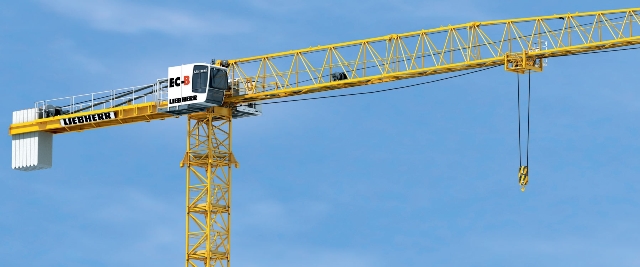
Tower crane jib
There are 2 points to be considered at the time of designing a flat top tower crane:
Tower crane jib length
Flexion of the jib
Tower cranes are designed following some calculations referring to the flexion of all the structure, not only the jib but also when the crane is working with load, minimum and maximum and working without load.
Both systems, conventional pendant lines tower crane and flat top tower cranes, are going to have a deformation of the structure due to the forces. The difference between these two concepts is how many meters the deformation is and what would be the way of absorbing it by the structure.
In every crane, the deformation of the structure depends on the load, the height, etc, so there are as many deformations as loads, etc you can have in your crane. The most important is designing the crane under calculations following security standards.
In the Flat Top cranes, the whole jib is having a deformation from the beginning of the jib, so this movement is not affecting to the stress of the steel structure because this movement is a natural movement.
In a conventional pendant lines tower crane, the jib is bending the complete jib, but there is a point under a big concentration of stress: where the pendant line is joined to the jib.
In the conventional pendant, lines tower crane, the last part of the jib, from the pendant line is joined up to the end, is bending more than in the flat top tower crane because there is nothing holding it and the structure is not as strong as in the flat top tower crane.
Tower crane safety
Problems in case of load fall
A load fall is not easy to happen, because there are many systems to control these difficult situations.
But in case of the load falls, the structure of the jib in the flat top cranes will move like if there was just a unique piece. The complete jib will absorb this movement.
By the design of the structure, the jib is ready to work in tension and compression at any time so this impact will have less effect in a flat top tower crane than in a pendant line, and the movement of the crane will decrease faster than in a conventional pendant lines tower crane.
In a conventional pedant lines tower crane, because the jib is not designed to absorb such a big force, this movement will be transmitted from the first part of the jib to the pendant line. It is ready for being worked just in tension, but not in compression so the upward movement of the structure will be bigger and larger than in the flat top tower cranes. And this movement will be uncontrolled

What is a tower crane?
Tower cranes are a common fixture at any major construction site. … The construction crew uses the tower crane to lift steel, concrete, large tools like acetylene torches and generators, and a wide variety of other building materials.
The base of the crane is bolted into the ground and weighed down by giant blocks of concrete. The stiffness of the supporting structure also helps counteract bending caused by unbalanced loads. Incorrect ballast will cause a crane to fall over.
A counterweight is a weight that, by exerting an opposite force, provides balance and stability of a mechanical system. Its purpose is to make lifting the load more efficient, which saves energy and is less taxing on the lifting machine.
In these applications, the expected load multiplied by the distance that load will be spaced from the central support (called the “tipping point”) must be equal to the counterweight’s mass times its distance from the tipping point in order to prevent over-balancing either side. This distance times mass is called the load moment.
The most read
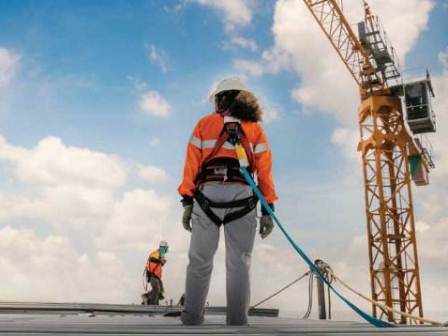
Tower Crane safety
Tower Crane Safety: Construction safety meeting topics, tower crane safety training, crane operator training, construction tower crane lighting requirements.

Hammerhead Tower Crane
A hammerhead tower crane is one of the most common types of cranes used around the world. They are especially reliable for precise, accurate handling of a wide variety of heavy materials.
